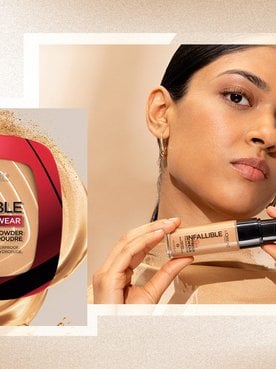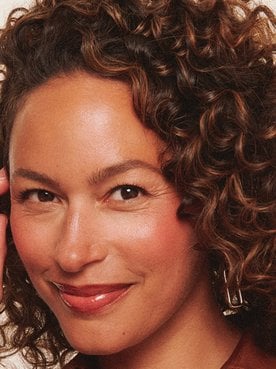In this article
If you’ve ever had a bad haircut, it’s likely you found yourself on Google, frantically searching “How long does it take for hair to grow?” While the average hair growth rate varies from person to person, you can’t expect your hair to grow longer overnight. It’s easy to become impatient with the idea of waiting months for your shorter strands to grow, and it may even leave you wondering whether you can make your hair grow faster.
The slow process may feel like hair purgatory, but there are some ways to support healthy hair growth. Below, we’re sharing what to know about hair growth, how much additional length you should expect to see per month, and tips on upgrading your haircare routine to promote long, healthy-looking hair.
The Hair Growth Cycle, Explained
Before we reveal how much your hair grows in a month or a year, a little context is needed. Though it may seem like your hair grows steadily, the process actually consists of three phases, which together span several years. Keep reading to learn about each phase of the cycle.
Anagen phase
The first phase of the hair growth cycle is the anagen phase. This, according to the Cleveland Clinic, is your hair’s active growth phase. New hair begins to take root (pun intended) within the hair follicle, and it slowly emerges from your scalp over time. In general, the anagen phase can last anywhere from two to seven years.
Catagen phase
After your hair completes its active growth phase, it enters a transitional period, known as the catagen phase. During this period, which lasts approximately two weeks, your hair slowly detaches from its underlying blood supply.
Telogen phase
Once your hair is fully disconnected from the underlying blood supply, it enters the telogen phase—a period of rest. This part of the hair growth cycle can last up to three months, after which the dead hair sheds and the follicle re-enters the active growth phase.
How Much Does Hair Grow In a Month?
Having explained the typical hair growth cycle above, you might be wondering whether it takes seven years for your hair to grow. Luckily, the answer to that is a resounding no. When it’s in the active growth phase, your hair grows about one centimeter per month, per the Cleveland Clinic.
Keep in mind that this is just an average, and that the rate of hair growth can vary slightly from person to person. How evident your hair growth is may also depend on several factors, including your hair type and texture. For instance, if you have curly hair, a centimeter of growth may not be all that noticeable. Likewise, if you have damaged hair with split ends, your hair may be growing—but if it’s snapping off at the ends, you’re unlikely to see a noticeable increase in length.
Can You Make Hair Grow Faster?
If you came here to learn how to grow your hair faster, the answer is, you can’t—not really. The rate at which your hair grows is determined primarily by genetics and can’t be sped up through any reliable means. With that being said, adopting a consistent haircare routine designed for your hair type, texture, and habits can help keep your hair looking and feeling its best as it grows out. The right routine can also help keep your hair strong, limiting the likelihood of developing concerns such as split ends or breakage.
How To Grow Out Your Hair: 3 Tips To Try
While there’s no answer to the question“How do I get my hair to grow faster?”, that doesn’t mean you’re totally out of luck if you’re looking to grow out your strands. The following habits won’t speed up the rate at which hair grows from your scalp, but they may help to address any damage hindering your long hair goals.
1. Reach for a bond-strengthening system
Damage can leave your hair susceptible to breakage, which can make it appear as if growth has stalled. To keep your hair strong and healthy-looking, consider swapping out your regular shampoo and conditioner for a bond-strengthening system. The L’Oréal Paris EverPure Bond Strengthening Pre-Shampoo Treatment, L’Oréal Paris EverPure Sulfate Free Bond Repair Shampoo, and the L’Oréal Paris EverPure Sulfate Free Bond Repair Conditionerwork together to reinforce weak hair bonds and strengthen the hair from the inside out. When used as a system, you’ll enjoy smoother, stronger hair and a reduction in breakage over time.
Shop the Products
2. Always use a heat protectant
Speaking of damage, try to keep heat styling to a minimum—exposure to high temperatures can dry out your hair, leaving it fragile and prone to split ends and breakage. If you must use heat to style your hair, be sure to prep your strands well with a dedicated heat protectant. The L’Oréal Paris EverPure Bond Repair Hair Oil-in-Serum gets our vote. The lightweight serum is designed specifically for dry, damaged hair and provides protection against temperatures up to 450 degrees Fahrenheit. Plus, it smooths, adds shine, and strengthens for glossy, healthy-looking hair.

3. Schedule regular trims
We know, we know—cutting your hair is probably the last thing you want to do when you’re trying to grow your strands out. But if you don’t get rid of split ends regularly, those splits can travel further up your hair shaft and result in breakage. To keep split ends at bay, we suggest getting a dusting (in other words, a micro-trim) every six to eight weeks.
4. Detangle with care
Brushing your hair roughly can lead to tangles, snarls, and snags, which can damage your hair and (you guessed it) lead to breakage. Instead, ditch the brush and gently detangle your hair with a wide-toothed comb after you shower. If you need a little aid in the detangling department, spritz your mane with a leave-in conditioner, such as the L’Oréal Paris EverPure Sulfate-Free Moisture 21-in-1 Leave-In Conditioner, before getting to work (bonus: this lightweight leave-in doubles as a heat protectant).

5. Deep condition once weekly
To give your hair the nourishment it needs to look and feel its best, consider adding a conditioning hair mask into your routine. The right formula can hydrate your strands, smooth frizz, and even strengthen your hair to help minimize breakage.
The L’Oréal Paris Elvive Total Repair 5 Damage Erasing Balm Rinse-Out Mask is a great pick for those growing out their hair. It contains a 17% repair concentrate with protein and helps smooth, nourish, and strengthen damaged hair. Plus, it’s an easy-to-use treatment that works its magic in as little as three minutes.
Shop the Products
Do Hair Growth Oils Work?
Some research suggests that natural oils, such as peppermint oil and castor oil, can help hydrate the scalp and potentially encourage hair growth. However, the effects are minor. A 2014 study published in Toxicological Research found that topical peppermint oil may help stimulate blood flow to the hair follicles and promote hair growth in mice. A different study published in the International Journal of Trichology shared that castor oil and fenugreek oil are used in some cultures to help promote hair growth. While using a hair growth oil is unlikely to cause harm, evidence showing the efficacy of these treatments is limited.
Do Hair Growth Supplements Work?
According to Harvard Health, your body requires certain nutrients—such as iron, zinc, and B vitamins—to grow strong, healthy hair. If you’re deficient in any of these nutrients, your hair may not grow as quickly as you’d like. In these cases, taking a multivitamin or a hair growth vitamin may help to encourage hair growth. However, for healthy individuals, there’s no concrete evidence to show that hair growth supplements provide any tangible benefits. If you’re interested in adding a hair supplement to your wellness routine, be sure to consult your doctor first.
Does Midoxinil Work for Hair Growth?
Minoxidil is an FDA-approved treatment that works to enhance hair growth. It primarily comes in the form of supplements or as a topical solution that is applied to the scalp. While it does work, it’s meant specifically for those experiencing premature hair loss. Additionally, it’s only effective as long as you continue using it—if you stop, your hair will revert to its normal growth pattern. That being said, it can be an effective solution for those experiencing extensive hair loss. A board-certified dermatologist or your primary care physician can help you determine whether or not Midoxinil is right for you.
What To Do If You Feel Like Your Hair Isn’t Growing
If you’re noticing less than average or no hair growth, the first thing to do is assess whether or not you may be experiencing hair loss. According to the Cleveland Clinic, most people lose between 50 and 100 hairs per day as part of normal hair shedding. That’s completely normal and not cause for alarm.
However, if you’re losing more than that or aren’t seeing any regrowth, it could be a sign of hair loss. Hair loss can be temporary—for example, a result of stress—or a sign of an underlying condition. To assess whether a medical issue is at play, we suggest scheduling an appointment with a board-certified dermatologist or licensed trichologist (a qualified hair loss specialist who studies the hair and scalp). They can assess your hair and scalp and recommend a course of action based on the underlying cause.
Next Up: Haircare 101: What Is Hair Made Of?
Photo courtesy of L’Oréal Paris







